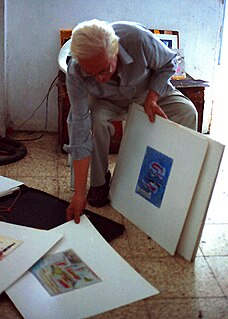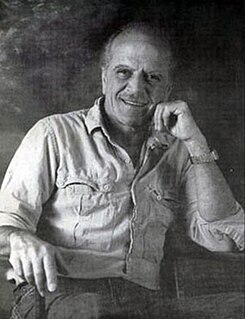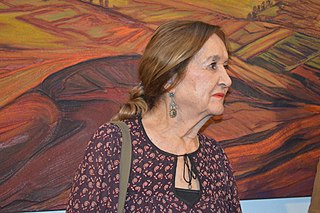
Arturo García Bustos was a Mexican painter and print maker. He is known as one of “Los Fridos” students who studied under Frida Kahlo at her home in Coyoacán.

Luis Enrique Tábara was a master Ecuadorian painter and teacher representing a whole Hispanic pictorial and artistic culture.
Aníbal Villacís was a master painter from Ecuador who used raw earthen materials such as clay and natural pigments to paint on walls and doors throughout his city when he could not afford expensive artist materials. As a teenager, Villacís taught himself drawing and composition by studying and recreating the illustrated ad posters for bullfights in Quito. In 1952, Jose Maria Velasco Ibarra, former President of Ecuador, discovered Villacís and offered him a scholarship to study in Paris.

Rodolfo Abularach was a Guatemalan painter and printmaker of Palestinian descent.
Eduardo X Arroyo is an Ecuadorian painter.
Fanny Rabel, born Fanny Rabinovich, was a Polish-born Mexican artist who is considered to be the first modern female muralist and one of the youngest associated with the Mexican muralism of the early to mid 20th century. She and her family arrived to Mexico in 1938 from Europe and she studied art at the Escuela Nacional de Pintura, Escultura y Grabado "La Esmeralda", where she met and became friends with Frida Kahlo. She became the only female member of “Los Fridos” a group of students under Kahlo’s tutelage. She also worked as an assistant and apprentice to Diego Rivera and David Alfaro Siqueiros, painting a number of murals of her own during her career. The most significant of these is "Ronda en el tiempo" at the Museo Nacional de Antropología in Mexico City. She also created canvases and other works, with children often featured in her work, and was one of the first of her generation to work with ecological themes in a series of works begun in 1979.
Amador Lugo Guadarrama was a Mexican painter, graphic artist, writer and cultural promoter, best known for his landscape painting and the founding of several cultural institutions. He began painting when still a child, attending the Escuela al Aire Libre de Pintura in Taxco then developing his career in Mexico City. At that time, the Mexican muralism school was still dominant. Lugo related to its aesthetics but not so much to its politics, so he participated in the founding of various institutions such as the Sociedad Mexicana de Grabadores and the Salón de la Plástica Mexicana which provided opportunities for artists outside the dominant movement. He also worked as an educator, writer and cultural promoter, mostly in Mexico City and his home state of Guerrero.
Ignacio Aguirre was a Mexican painter and engraver.
Javier Arevalo was a contemporary Mexican artist whose work was the subject of many exhibitions, worldwide, including in Europe, Latin America, United States, Mexico and Japan. His influence was greatest in Mexico City, and Guadalajara, Jalisco. He also taught Art at the Palacio de Bellas Artes in Mexico City.

Alfredo Zalce Torres was a Mexican artist and contemporary of Diego Rivera, David Siqueiros and other better-known muralists. He worked principally as a painter, sculptor, and engraver, also taught, and was involved in the foundation of a number of institutions of culture and education. He is perhaps best known for his mural painting, typically imbued with "fervent social criticism". He is acclaimed as the first artist to borrow the traditional material of coloured cement as the medium for a "modern work of art". Publicity-shy, he is said to have turned down Mexico's Premio Nacional de Ciencias y Artes before finally accepting it in 2001. Before his death, Sotheby's described him as "the most important living Mexican artist up to date".

José Julio Gaona is a Mexican painter noted for his depictions of women and girls in strong lines and bright colors, usually doing ordinary activities. Member of the Salón de la Plástica Mexicana and other professional organizations in Mexico, he has had over 135 exhibitions of his work in both Mexico and abroad.
Ignacio Ortiz is a Mexican painter and teacher noted for his depictions of women and his work in the development of the fine arts program at the Universidad Autónoma de Nuevo León. He began his career at the same university as a student, with advanced studies in Europe. He has had individual and collective showings of his work in Mexico, the United States and various countries in Europe. He is a member of the Royal Union of Swedish Painters and the Salón de la Plástica Mexicana. In 2005, the Museo Metropolitano de Monterrey gave him an award for his life’s work and contributions to the culture of Monterrey.
José Victor Crowley is a self-taught Mexican painter who specializes in abstract informalism. He is classified as a member of the Generación de la Ruptura, and his influence is strongly based on his experience in Europe at the beginning of his career. His career has spanned over fifty years, becoming a member of Mexico’s Salón de la Plástica Mexicana in 2006.
Enrique Echeverría Vázquez (1923–1972) was a Mexican painter, part of the Generación de la Ruptura and early member of the Salón de la Plástica Mexicana. He was one of a number of painters who broke away from the established painting figurative style in Mexico in the mid 20th century to experiment with abstractionism and other modern movements in painting from Europe. Although his career was followed by other artists and critics, he died in the early 1970s when painters of his generation were only beginning to receive widespread recognition for their work. While meriting two major exhibits at the Palacio de Bellas Artes in Mexico City, one just after his death and a retrospective thirty years later in 2003, he and his work are not well known among younger Mexican painters.
Jesús Álvarez Amaya was a Mexican painter and graphic artist, mostly known for mural work and his graphic work as head of the Taller de Gráfica Popular, which he led from 1967 until his death. His murals can be found in various parts of the country and his art mostly have social and political themes.

Rina Lazo Wasem was a Guatemalan-Mexican painter. She began her career in mural painting with Diego Rivera as his assistant. She worked with him from 1947 until his death in 1957 on projects both in Mexico and Guatemala. Thereafter, she remained an active painter, better known for her mural works than canvases, although the latter have been exhibited in Mexico and other countries. This has made her one of Guatemala's best-known artists. She was a member of the Mexican muralism movement and criticized modern artists as too commercial and not committed to social causes. She believed muralism would revive in Mexico because of its historical value.

Guillermo Ceniceros is a Mexican painter and muralist, best known for his mural work in Mexico City, as well as his figurative easel work. He began his mural painting career as an assistant to mural painters such as Federico Cantú, Luis Covarrubias and then David Alfaro Siqueiros who was a mentor and a key influence. Ceniceros is the most notable of Siqueiros' assistants. While he has experimented with abstract expression, his easel work mostly classifies as figurativism and is influenced by the geometrical construct of Mexican muralism. He has had over 300 individual and collective exhibitions in Mexico and the International stage. His work has been recognized by the Mexican Ministry of Culture and several of its institutions. He has painted over 20 large scale Mural Paintings with some of the most notable being the large scale work for the Legislative Palace of San Lazaro as well as his murals in the Metro Subway System. He is a member of the Salón de la Plástica Mexicana. In 1995, the State of Durango, Ceniceros' native state, opened to the public the Guillermo Ceniceros Art Museum within the oversight of the Ministry of Culture. Ceniceros has been reviewed by notable critics such as Berta Taracena, Raquel Tibol, Alaide Foppa, Graciela Kartofel, José Angel Leyva and Eduardo Blackaller among others. There are several publications about his work including a vast review of his art life endeavors developed by the Ministries of Culture of Durango and Nuevo León. He is married to the artist Esther González and lives in his studio house in the Colonia Roma of Mexico City.

Sarah Jimenez Vernis was a Mexican artist known for her political graphic work in the mid 20th century, especially with the Taller de Gráfica Popular, earning her membership in the Salón de la Plástica Mexicana. After her time with the Taller, her career shifted to teaching, and her work became mostly forgotten. However, there have been efforts to revive interest in it.
Rocio Caballero is a Mexican figurative painter, whose works often depict mythical worlds and are noted for her use of symbolism. Her work has been exhibited individually and collectively in Mexico, the United States, South America and Europe and can be found in collections such as that of the National Museum of Mexican Art. Her work has been recognized with membership in the Salón de la Plástica Mexicana.
Paula Lazos was a Mexican painter whose work has been exhibited in both North and South America and recognized with membership in the Salón de la Plástica Mexicana.








